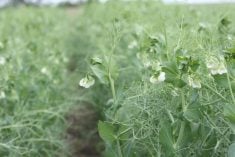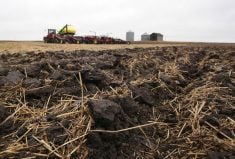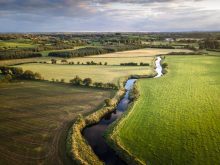David Rourke, a 67-year-old grain farmer from Minto, Man., made it clear he’s not in competition with his mother, but he’s obviously cut from a similar cloth.
After earning a master’s degree in education and then a master’s degree in nursing, Rourke’s mom went back to school in her 50s to pursue a PhD in nursing.
Rourke got started a little later than his mom, who passed away two years ago, but at 65 he began working on a PhD thesis from the University of Manitoba.
Read Also

Short rapeseed crop may put China in a bind
Industry thinks China’s rapeseed crop is way smaller than the official government estimate. The country’s canola imports will also be down, so there will be a lot of unmet demand.
The topic is sustainable grain farming with the title, In Search of Net Positive Carbon Grain Farming in Western Canada: Innovation in Policy and Practice.
The idea behind his PhD is less complicated than the title.
Rourke plans to interview farmers from the Prairies and northern U.S. Plains who want to reduce greenhouse gas emissions from cropland and still produce robust yields.
At this point, he’s trying to find producers who believe crop production needs to evolve and improve.
“We do have the responsibility to feed a certain number of people … and (produce) fuel to some degree, and we have a responsibility to fix the harm we’ve done to the Earth,” he said.
“This is trying to find that balance and trying to find farmers who are taking (this) seriously. To figure out, on a scalable basis, how we might tackle this responsibility.”
The premise of his thesis is to talk to producers rather than academics or idealists. He hopes to identify realistic and progressive solutions instead of lunatic fringe ideas in which prairie farmers go back to living in sod huts and plowing their fields with oxen.
“What I’m grappling with, right now, is how to handle all those different types of voices. I think I have to because there isn’t a single solution.”
A number of Canadian farm groups and organizations are promoting “net zero” agriculture by 2050, in which farmers will dramatically cut fossil-fuel use and greenhouse gas emissions.
Rourke thinks grain farmers can go beyond net zero.
“Agriculture has that added advantage of being able to sequester carbon into the ground…. That’s why I call it net positive.”
He will listen to other producers, but Rourke has some of his own ideas and potential solutions.
Rourke and his wife, Diane, started grain farming in 1980, beginning with a half section of land. At the time, he was also working as a winter wheat agronomist, trying to convince farmers to seed winter wheat directly into crop stubble. In 1981, Rourke received a master’s degree for his research into zero till.
That work convinced him to try zero till on his farm, which has since grown to 6,000 acres.
The Rourkes embraced zero till for about 35 years, but starting in 2017 they decided to go a little further. They became zero-till and organic.
“There was a desire to be a little bit more self-sufficient,” Rourke said.
He continued with organic until 2022 but stopped because he doesn’t think large-scale organic grain farming produces sufficient yields in Western Canada.
It might work as a niche system, but it’s not going to work on 70 million acres of cropland across the Prairies, he added.
“Organic in this area is not really a scalable solution…. We concluded after five years that moisture is precious in Western Canada,” he said.
“In some of the drier years … we couldn’t get our cover crops to grow consistently.”
As well, organic grain farming requires tillage for weed control, but tillage dries out the soil.
“Whenever you till, you create kind of a micro-drought.”
Rourke also has thoughts on cover crops, which are seeded to improve soil fertility and keep a living plant on a field for the maximum number of days per year.
The federal government has been promoting them as a potential solution to climate change. In 2022, Agriculture Canada announced $182.7 million in funding to encourage farmers to plant cover crops, try rotational grazing of livestock and change their management of nitrogen fertilizer.
Seeding cover crops following harvest is a nice concept. Under the right conditions, they can boost soil health and fertility.
But in the cool and dry climate of Western Canada, cover crops are difficult.
“If we’re defining it as a crop that’s seeded post-harvest, in the fall, expecting significant growth and it’s going to have significant impact … from my personal experience, I don’t think it’s the right (approach),” said Ryan Boyd, who farms near Brandon and is an advocate for regenerative agriculture.
“We live here in a northern climate, and our biggest challenge is the short (growing) season…. Expecting the farmer to seed a cover crop while they’re harvesting … we have such a narrow window (at harvest time). That’s not an excuse. It’s reality.”
Rourke has the same opinion, saying fall-seeded cover crops are not realistic.
“Sow that cover crop … and do it while you’re combining, and take $30 to $70 (per acre) out of your pocket and hope sometime in the future you’ll get a return on your investment?”
He wonders if another option is feasible.
Maybe it’s possible to plant a cover crop in the spring, at the same time the cash crop goes in the ground. However, the cover crop seed is coated, so it delays germination.
“It won’t germinate until about 80 days later. Then we don’t have to go back and seed (in the fall). It’s in the ground.”
Rourke has many other thoughts about net positive grain farming, but he wants to hear from other producers.
He’s hoping to interview those who believe it’s important to reduce emissions, store more carbon in the soil and be part of the solution.
“I’m really curious to see what kind of innovations people have, in those areas. That will get us closer to this net positive.”
Producers who want more information or are willing to share their thoughts can contact Rourke at rourked@myumanitoba.ca.
















